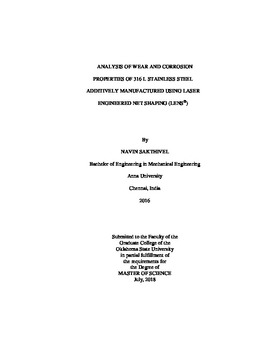| dc.contributor.advisor | Harimkar, Sandip P. | |
| dc.contributor.author | Sakthivel, Navin | |
| dc.date.accessioned | 2019-03-25T20:05:23Z | |
| dc.date.available | 2019-03-25T20:05:23Z | |
| dc.date.issued | 2018-07-01 | |
| dc.identifier.uri | https://hdl.handle.net/11244/317697 | |
| dc.description.abstract | Additively manufactured stainless steel 316 L complex shaped components are used in various industries like oil and gas, chemical industries etc. for its excellent corrosion resistance and tribological properties. Additive manufacturing of stainless steel 316 L is inevitable in the applications requiring complex shapes, which cannot be manufactured conventionally. In such applications, complex shaped components are fabricated using additive manufacturing. Due to laser melting and rapid solidification in the layer-by-layer densification in additive manufacturing, the microstructural evolution in additive manufacturing is drastically different from conventional manufacturing methods. This results in difference in the electrochemical and tribological behavior of additively manufactured stainless steel 316 L. In this research, corrosion and wear properties of stainless steel 316 L additively manufactured using LENS® was analyzed. Samples were additively manufactured under different processing conditions of laser power, laser scanning speed and powder deposition rate. The results show that in the as-built surfaces, wear is found to be inversely proportional to the laser power. When the effect of surface roughness is eliminated, the wear is found to be directly proportional to laser power. Laser scan speed is found to be directly affecting the weight loss due to wear. The effect of powder deposition rate on the wear and corrosion characteristics of stainless steel 316 L additively manufactured using LENS® is found to be inconsistent. The corrosion potential of stainless steel 316 L additively manufactured using LENS® is lesser than that of wrought stainless steel 316 L. The corrosion potential of stainless steel 316 L additively manufactured using LENS® was higher than the wrought at high laser energy densities. The corrosion potential and subsequently corrosion resistance increased with laser power. It was observed that the additively manufactured stainless steel 316 L using LENS® shows improved pitting resistance than the wrought stainless steel 316 L. The stress relieving heat treatment imparted enhanced pitting corrosion resistance. | |
| dc.format | application/pdf | |
| dc.language | en_US | |
| dc.rights | Copyright is held by the author who has granted the Oklahoma State University Library the non-exclusive right to share this material in its institutional repository. Contact Digital Library Services at lib-dls@okstate.edu or 405-744-9161 for the permission policy on the use, reproduction or distribution of this material. | |
| dc.title | Analysis of Wear and Corrosion Properties of 316 L Stainless Steel Additively Manufactured Using Laser Engineered Net Shaping (LENS®) | |
| dc.contributor.committeeMember | Kidd, James Allan | |
| dc.contributor.committeeMember | Vaidyanathan, Ranji | |
| dc.contributor.committeeMember | Vora, Hitesh D. | |
| osu.filename | Sakthivel_okstate_0664M_15903.pdf | |
| osu.accesstype | Open Access | |
| dc.description.department | Mechanical and Aerospace Engineering | |
| dc.type.genre | Thesis | |
| dc.type.material | text | |
